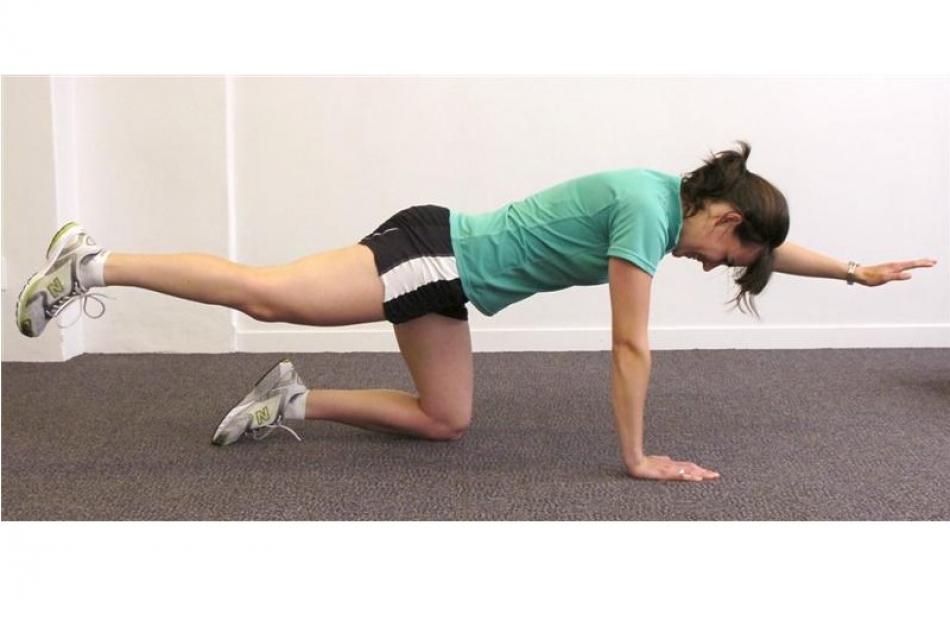More is better when it comes to alleviating lower back pain - more exercise, that is. Although many people who suffer from back pain don't exercise, fearing it will exacerbate the problem, a recent study found that exercising four days a week gave people greater relief from back pain than working out fewer times a week or not at all. Fitness expert Gary Dawkins offers some tips.
Lower back pain is a major health concern for many people, but there is some good news.
A lot of it can be prevented or resolved with little effort.
This could mean changing habits, starting a specific exercise and stretching programme, or simply purchasing a new office chair.
Lower back pain can cause injuries to other areas of the body, so it is important to do something about it.
There are so many pain receptors in the back that the smallest of abnormalities will cause pain.
• Pains in the back
1. Poor seating posture at the workplace:
Lower back pain can begin with poor posture at the work station. This is the result of sitting in a position that is out of the body's "normal" anatomical position.
Often the chair is set up to do the work that our abdominal muscles should be doing.
The lower back is in a constant position of flexion and is totally supported by the chair, allowing supporting lower abdominal muscles to relax, so for most of the day the body can be lazy and the muscles don't have to work in synergy.
2. Poor standing posture:
We see it all the time - shoulders dropped forward and rounded. The result is a posture out of the "normal" anatomical position, placing too much force on the lower back.
The correct anatomical position is when your ears, shoulders and tail bone are all aligned.
Try standing or sitting up straight in this position. It will probably feel strange because most of us do not stand or sit correctly.
3. Obesity:
The back has too much load placed on it. Being overweight places excessive strain on the lower back because of the difficulties in assuming normal posture.
4. Chemical irritation:
Chemicals, such as smoke, entering the body can initiate lower back pain.
5. Psychological factors:
Excess stress and being overtired can initiate lower back pain.
6. Mechanical abnormalities:
Poor hamstring (back of the upper leg) and gluteus strength and poor hip flexor (front thigh) flexibility.
• What can you do to alleviate lower back pain? If you have lower back pain that is not a result of a direct injury:
• Visit an osteopath to find the cause of the pain.
• Find comfortable seating positions.
• Reduce the pain by reducing the inflammation.
• Do only gentle activity until you know the cause.
• Be active only in pain-free ranges of motion.
• If walking uphill or on stairs is painful, simply keep yourself isolated from those activities.
• Do not remain bed-ridden as this will only aggravate the condition.
• Wear comfortable footware.
• If you have poor posture then use the flexibility and mid-region strengthening programme on this page to start correcting it.
• If you are overweight, start the 10-week Body and Soul exercise programme.
• If you can't touch your toes while standing up then start the flexibility programme. You most probably have very tight muscles throughout your lower body.
• It may just be that you store lots of stress as a result of a lack of sleep or the pressures of daily life - if this is the case then take a close look at your lifestyle and make the appropriate changes.
• A light exercise programme will work two-fold - it will relieve your stress and also help loosen up tight muscles and joints which is often all that is required to help relieve chronic lower back pain.
• Once pain has been eliminated, it is important to continue with a long-term maintenance programme to prevent recurrence.
• Helping to prevent lower back pain:
• Complete a regular flexibility and strengthening programme aimed at loosening up the hamstring and hip flex muscles as well as being aimed at strengthening the hamstring and trunk muscles.
• Keep active, as this frees the joints and keeps them mobile.
• Maintain a healthy body weight.
• Don't smoke.
• Maintain a correct posture when sitting and when standing. This may mean purchasing a chair that allows you to keep a straight back.
• A Swiss ball can be a great seat as it ensures you activate your abdominal muscles to keep your back straight. This also means standing and walking tall with your shoulders back.
• Get enough sleep and relieve stress through regular activity.
• Always use your back correctly. This means use your legs to take the majority of the weight when lifting and bend through your knees and hip.
• When driving in the car or sitting at work, try to get into a habit of contracting (tensing) your lower abdominals at about 25%. To do this, imagine you are attempting to do a belt up one more notch. For example, at the traffic lights do this until the lights turn green.
• Gary Dawkins is personal trainer and director of Creative Conditioning in Dunedin.

